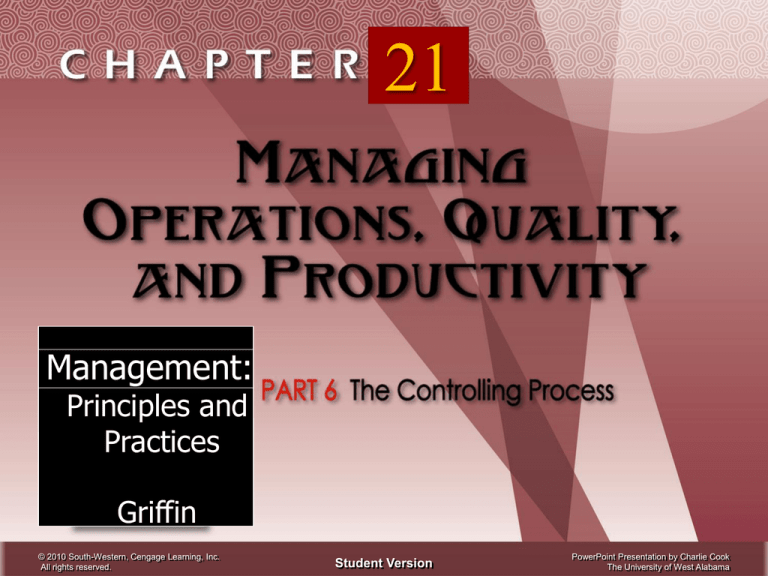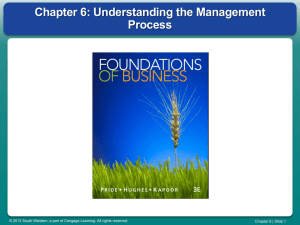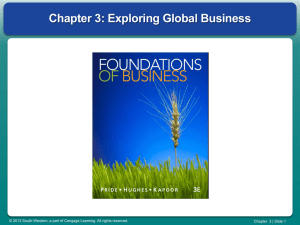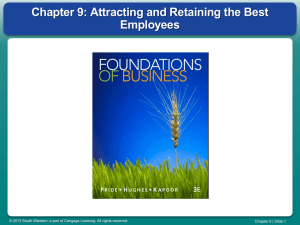
21
Management:
Principles and
Practices
Griffin
© 2010 South-Western, Cengage Learning, Inc.
All rights reserved.
Student Version
PowerPoint Presentation by Charlie Cook
The University of West Alabama
The Nature of Operations Management
• Operations Management
The set of managerial activities used by an
organization to transform resource inputs into
products, services, or both.
• Importance of Excellence in Operations
Is necessary for competitiveness and overall
organization performance.
Creates value and utility through the production of
products and services.
© 2010 South-Western, Cengage Learning, Inc. All rights reserved.
21–2
Types of Operations
• Manufacturing
A form of business that combines and
transforms resource inputs into tangible
outcomes that are then sold to others.
• Service organization
An organization that transforms resources
into an intangible output and creates time
and place utility for its customers.
© 2010 South-Western, Cengage Learning, Inc. All rights reserved.
21–3
Operations and Organizational Strategy
• Role of Operations in Organizational Strategy
Operations management has a direct impact on
competitiveness, quality, productivity, and
effectiveness.
Operations management and organizational strategy
have reciprocal effects on each other.
Strategic goals cannot be met if there are deficiencies
and insufficiencies in operations resources.
© 2010 South-Western, Cengage Learning, Inc. All rights reserved.
21–4
Designing Operations Systems
• Determining Product-Service Mix
Involves deciding how many and what kinds of
products to offer in the marketplace.
• Capacity Decisions
Involve choosing amount of products, services, or
both that can be produced by an organization.
Can be high-risk decisions due to uncertainty about
future product demand and incurred costs of
additional, possibly excess, capacity.
© 2010 South-Western, Cengage Learning, Inc. All rights reserved.
21–5
Designing Operations Systems (cont’d)
• Facilities Decisions
Facilities are the physical locations where products or
services are created, stored, and distributed.
Location is the physical positioning or geographic site of
facilities.
Layout is the physical configuration of facilities, the
arrangement of equipment within facilities, or both.
Types of layouts
Product layout
Process layout
Fixed-position layout
Cellular layout
© 2010 South-Western, Cengage Learning, Inc. All rights reserved.
21–6
Organizational Technologies
• Manufacturing Technology
Technology
The set of processes and systems used by organizations
to convert resources into products or services.
Automation
The process of designing work so that it can be completely
or almost completely performed by machines.
Computer-assisted manufacturing (CAM)
Computer-aided design (CAD)
Computer-integrated manufacturing (CIM)
Flexible manufacturing systems (FMS)
© 2010 South-Western, Cengage Learning, Inc. All rights reserved.
21–7
Organizational Technologies (cont’d)
• Service Technology
Services are rapidly moving toward automated
systems and procedures (e.g., automated teller
machines and room reservations).
© 2010 South-Western, Cengage Learning, Inc. All rights reserved.
21–8
Operations Systems in
Supply Chain Management
• Supply Chain Management
• Operations Management as Control
• Purchasing Management (Procurement)
• Inventory Management
© 2010 South-Western, Cengage Learning, Inc. All rights reserved.
21–9
Managing Total Quality
• The Meaning of Quality
The totality of features and characteristics of a
product or service that bear on its ability to satisfy
stated or implied needs.
Quality is both a relative and absolute concept.
Quality is relevant to both products and services.
• The Importance of Quality
Malcolm Baldrige Award
Named after a former secretary of commerce, this award is
given by the Commerce Department to firms that achieve
major quality improvements.
© 2010 South-Western, Cengage Learning, Inc. All rights reserved.
21–10
Managing Productivity
• Productivity
An economic measure of efficiency that summarizes
the value of outputs relative to the value of resources
used to produce them.
Aggregate productivity
Industry productivity
Levels of Productivity
Company productivity
Unit productivity
Individual productivity
© 2010 South-Western, Cengage Learning, Inc. All rights reserved.
21–11
Key Terms
•
•
•
•
•
•
•
•
•
•
•
operations management
manufacturing
service organization
product-service mix
capacity
facilities
location
layout
product layout
process layout
fixed-position layout
© 2010 South-Western, Cengage Learning, Inc. All rights reserved.
•
•
•
•
•
•
•
•
•
•
cellular layout
technology
automation
computer-assisted
manufacturing
robot
supply chain management
purchasing management
inventory control
just-in-time (JIT) method
quality
21–12
Key Terms (cont’d)
•
•
•
•
•
•
•
•
Malcolm Baldrige Award
value-added analysis
benchmarking
outsourcing
cycle time
ISO 9000:2000
ISO 14000
statistical quality control
(SQC)
• Six Sigma
© 2010 South-Western, Cengage Learning, Inc. All rights reserved.
• total quality management
(TQM, also called quality
assurance)
21–13





